- You are here:
- Home »
- Trukan
Tag Archives for " Trukan "

Defend in a Deep Lying Block Defense – Aerobic Power
By Anthony Hazelwood
Defend in a Deep Lying Block Defense – Aerobic Power. Defend in a Deep Lying Block Defense – Aerobic Power. The following activity coaches a team to defend in a deep lying block defense. The specific fitness target is transient endurance while adapting the player’s aerobic power in an extended small-sided format.
When preparing the activity, if needed, concentration and difficulty levels may be increased by having players execute something extra unique by setting more restrictions. Every activity may be modified, and it is up to the coach to be creative. However, it is important to respect the parameters of the exercise time, the rest, the types of actions used and the weekly periodization of the activity.
Additionally, it is beneficial to train a soccer team and its players with all the elements of the game being present in the session. By doing so, it will promote soccer specific adaptations to the player’s body, mind and emotional triad. Ultimately, these adjustments will enhance their real-time game performances on a physical, emotional, conscious, and subconscious mental level.
Area Size: 50 yds. Length X 60 yds. Width
Total Activity Time: 20 Minutes.
Sets: 1.
Intervals: 3. Activity Time: 6 minutes.
Recovery Interval Time between Sets: 1 minute.
Intensity: High.
Objectives:
• Tactical: Defend as a team in a deep lying block defense. Defensive individual, small group and team collective defending principles of play.
• Fitness: Aerobic Power. Ability to play through three repetitions at a high rate.
• Technique: Proper fitness and off/on the ball execution/techniques.
• Mental-Emotional: Players fully engaged and concentration is high.
• Concentration Level: High.
Setup:
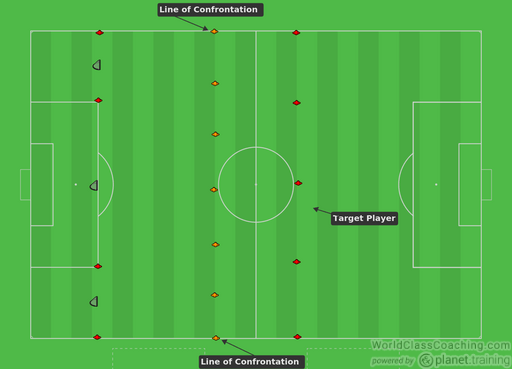
• Yellow team (4-4-1) trains to defend in a low-lying compact box shape.
• There are three goals (6 yds.) placed at the yellow teams end line.
• A Target player is located at the black team’s end line and may only run side to side on the line.
• A line of confrontation is located 30 yds. from the yellow teams end line.
• Yellow team may not defend beyond the line of confrontation.
• Black team (4-2-3) starts with the ball and looks to score through one of the three goals by either passing or dribbling through it.
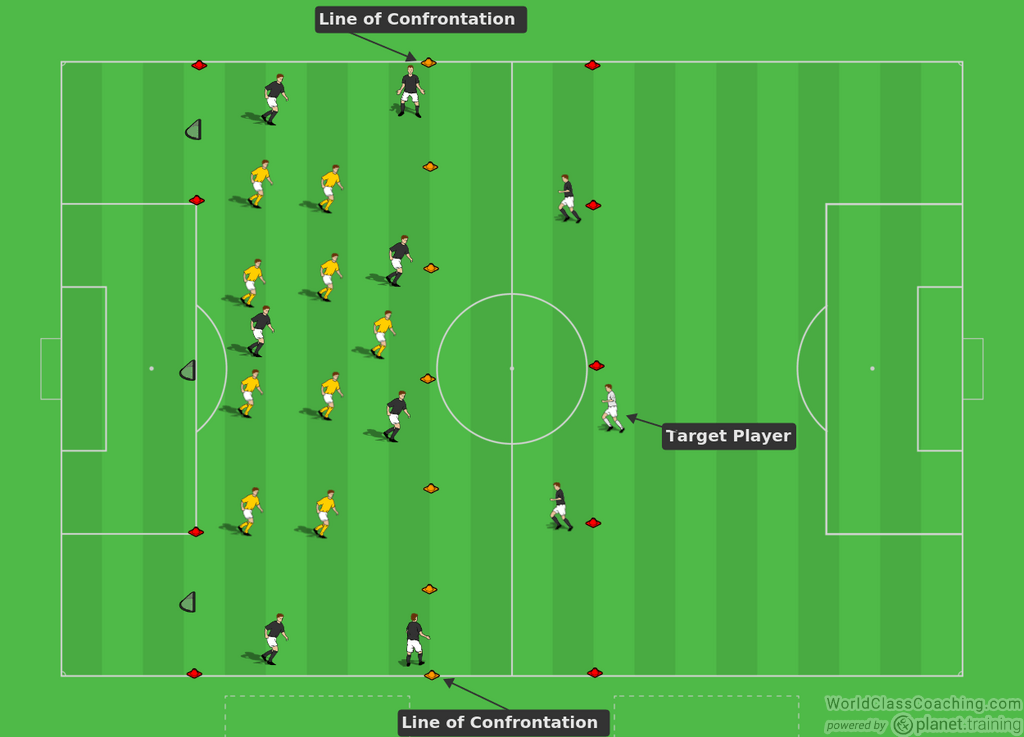
• Yellow team looks to defend the three goals.
• If the defending yellow team wins back the ball, they look to transition into attack and find the target player. They may go beyond their line of confrontation when in possession.
• Once they find the target player, the teams quickly recover below the line of confrontation and begins to defend again.
• Target player plays with black team during possession and is available to receive passes from yellow team when they are in possession.
Coaching Points:
• Defending team works collectively to protect three goals.
• Collective shifting and understanding of roles in zones.
• Pressure, Cover and Balance concepts.
• Team yellow recovers into a deep lying defensive shape after a turn over to the Target player or when taken away by the defending team.
By Anthony Hazelwood
Current Seattle Sounders Academy Performance Coach with previous European academy coaching experience as an assistant fitness and strength/conditioning soccer coach with Levante U.D. (2013-2014) and Getafe SAD CF (2015-2016) in Valencia and Madrid, Spain respectively. A USSF “A” licensed coach with a BSc in Physical Education and an MSc in Sports Training and Nutrition.
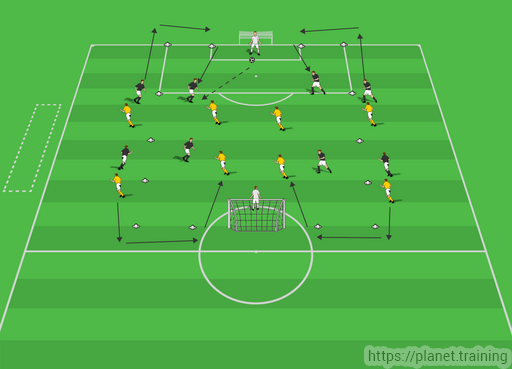
Continuous 4v4 with Capacity to Recover
By Alex Trukan
This game is focused on developing players’ capacity to recover quick bursts. The quicker energy stores will be refuelled, the more intense actions can be produced early. These outcomes are achieved within highly engaging 4v4 games scenario which improve players’ decision making, wide range of technical abilities as well as working as a team. It also challenges players’ concentration and dealing with pressure as the game finishes if one of the teams scores!
Set up and directions
Organise 30 x 45 yards pitch with two goals as shown on the diagram below. Assign goalkeepers to goals. Divide the team into two groups of eight. Then further divide the groups into two teams of four. First two groups start on the pitch, the other two wait on the side of the goals. Prepare a sufficient supply of balls in goals.
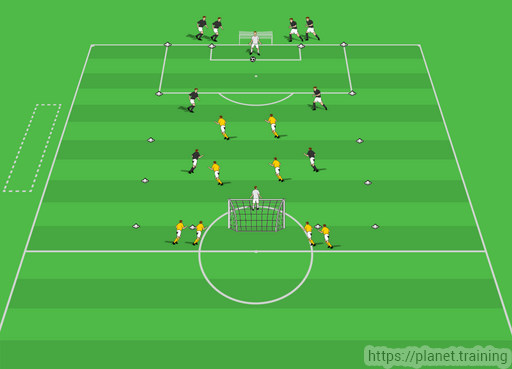
The practice starts with one of the goalkeepers playing the ball out into the attacking team. Then, the game continues with both teams trying to score in the opposite goals. No corners apply – the game is restarted from the goalkeeper.
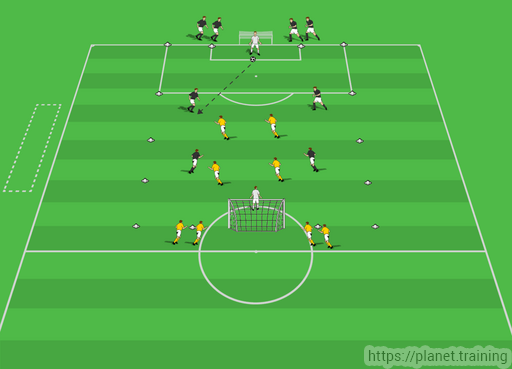
The game continues until one of the teams score a first goal. The pitch is relatively long for this format so direct play and quick combinations should be encouraged. Both teams come off the pitch when the first goal is scored. The team that scored it gets 1 point.
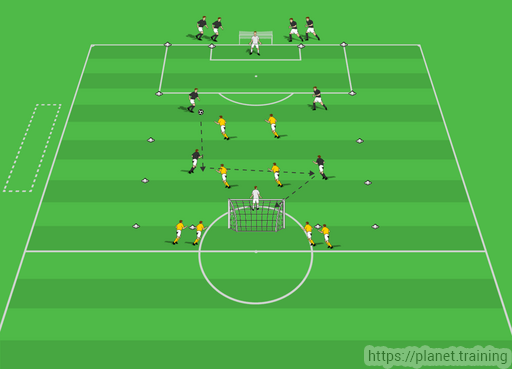
As soon as the goal is scored and two teams come off the pitch, the next two come onto it straight away and the game continuous with new 4v4s. Points from both teams get accumulated and the final score decides the winner.

Timing:
Each team should complete 6-10 repetitions (min. 12 games) in 2 series. Rest between repetitions should be 1-3 minutes and between series – 4 minutes.
Variations:
– 3v3’s
– The quicker the goal is scored the more it is worth (ex. within 1 min. – 3 points)
– No back passes allowed
By Alex Trukan, Development Coach, Nottingham Forest – @AlexTrukan
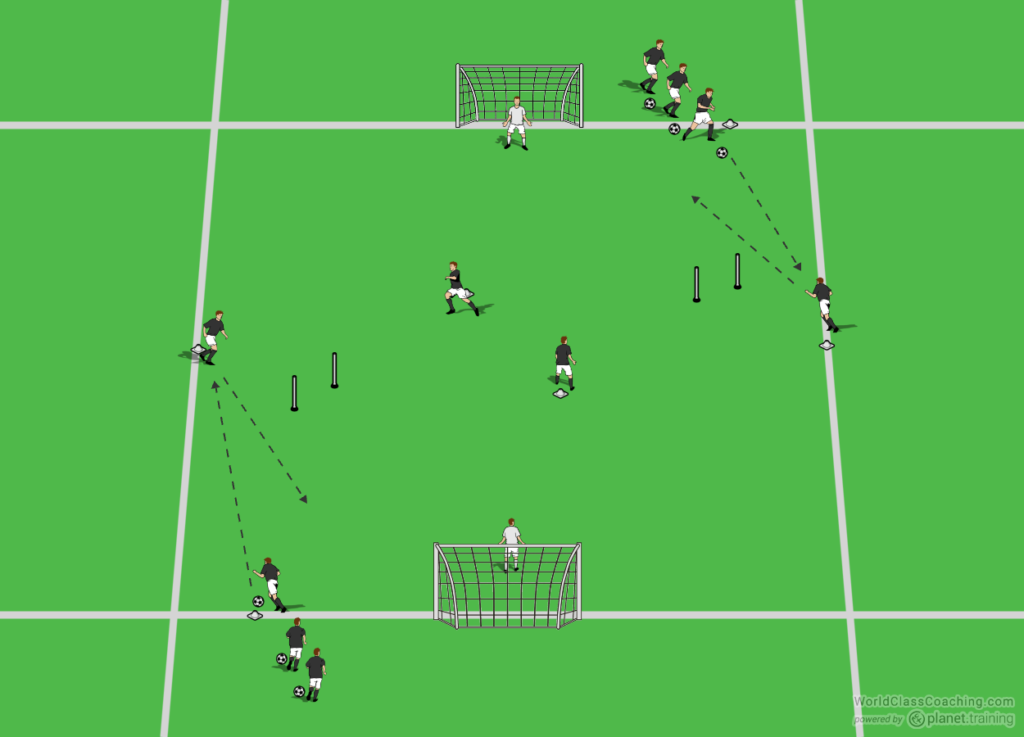
Shooting Combination with Starting Speed
By Alex Trukan
Shooting combination practice involves working on starting speed around the penalty box. This is important for players in order to gain advantage near the goal and be able to get to the ball before the defender. This in turn will help players to get into more goal scoring situations and eventually, score more goals. In this practice, the conditioning element is therefore linked to technical content of finishing as well as combination play in the final third.
Set up and directions
Organise two goals opposite to each other, 30 yards apart. Set up a cone next to the goal which will be starting point of the exercise. Organise further two cones (one on the angle to the left from the starting point and one on the angle to the right). There should be minimum 8-10 yards distance between the cones Set up a gate using two poles as shown on the diagram below. Divide the players into two groups. Set one player each on the cones in the middle and the rest of the players with one ball each on the starting cone. Goalkeepers should be set and ready in goals.
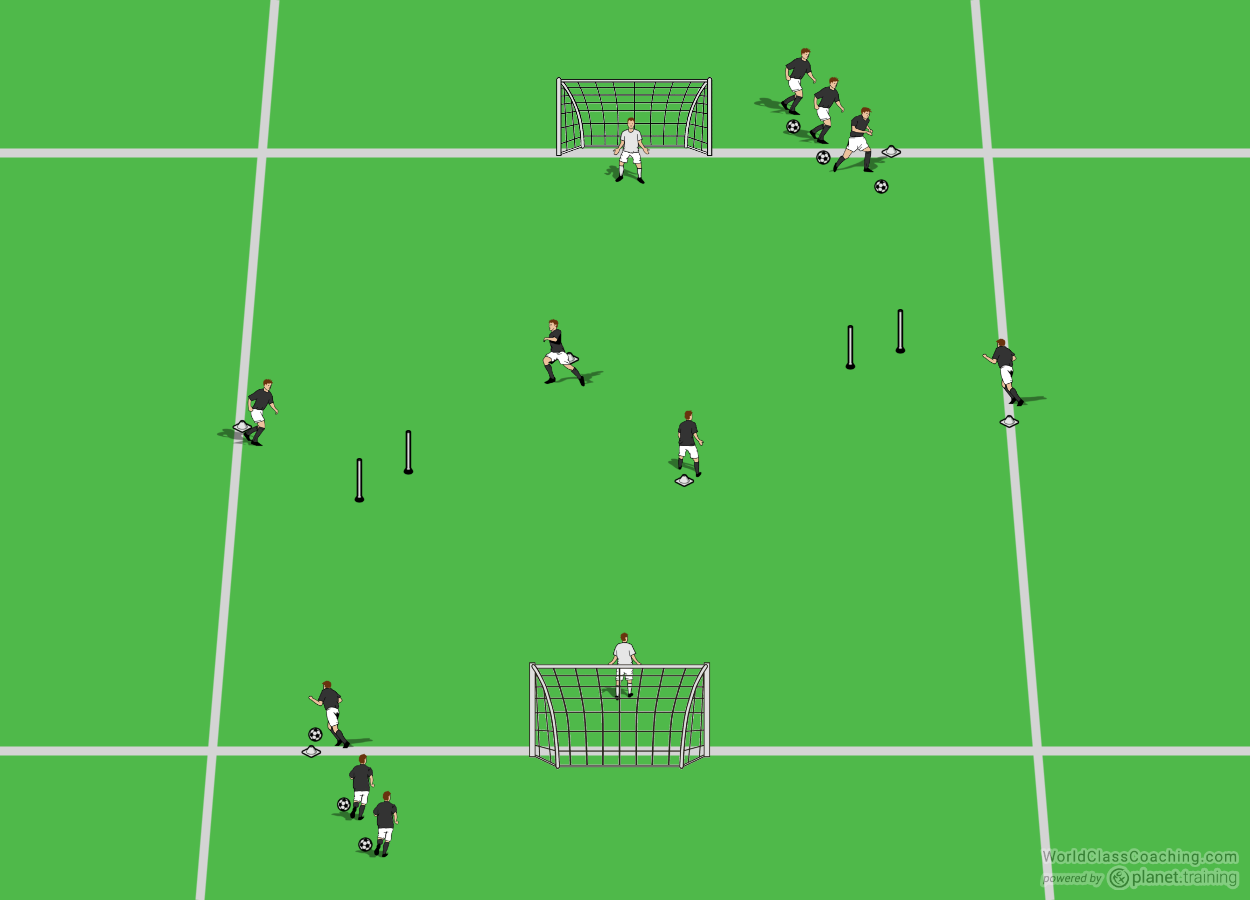
The practice starts with first player with the ball passing it to the player positioned on the cones to his left. The ball is then returned back on the angle using one touch. Both groups start at the same time.
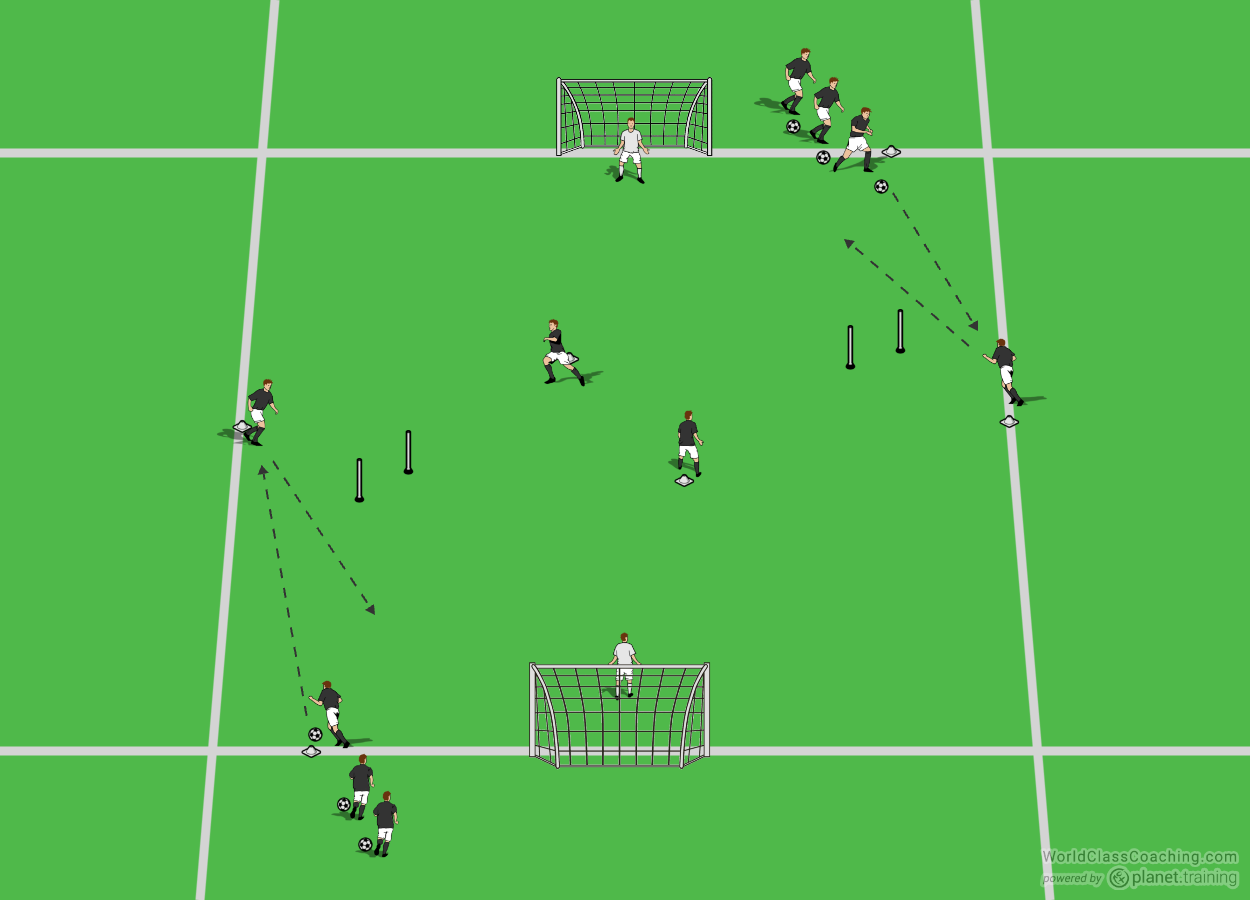
The player that started the practice passes the ball to the player positioned on the cone to his right. This pass is crucial for next sequence of the pattern and therefore should be played with high quality (allowing the receiver to play off one touch).
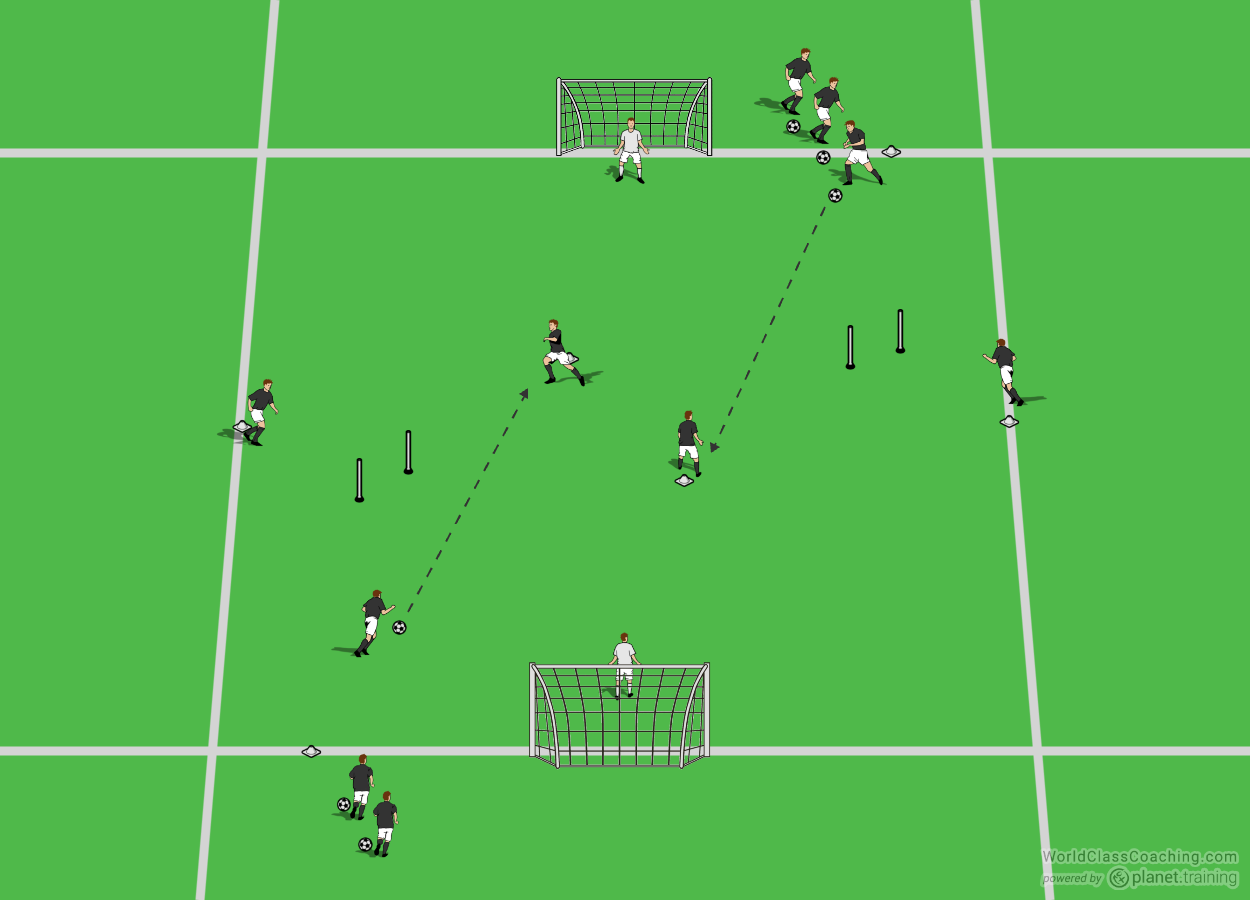
Following that, the receiver sets the ball on the angle. At the same time, the second player in a sequence makes a quick and sharp movement through the gate to then sprint onto the ball and finish in goal. This should be done on maximal speed. Players rotate clockwise (‘starting’ player-‘shooting’ player-‘setting’ player). As soon as one pattern finishes, the next one should start immediately to ensure appropriate work to rest ratios and flow of the practice.
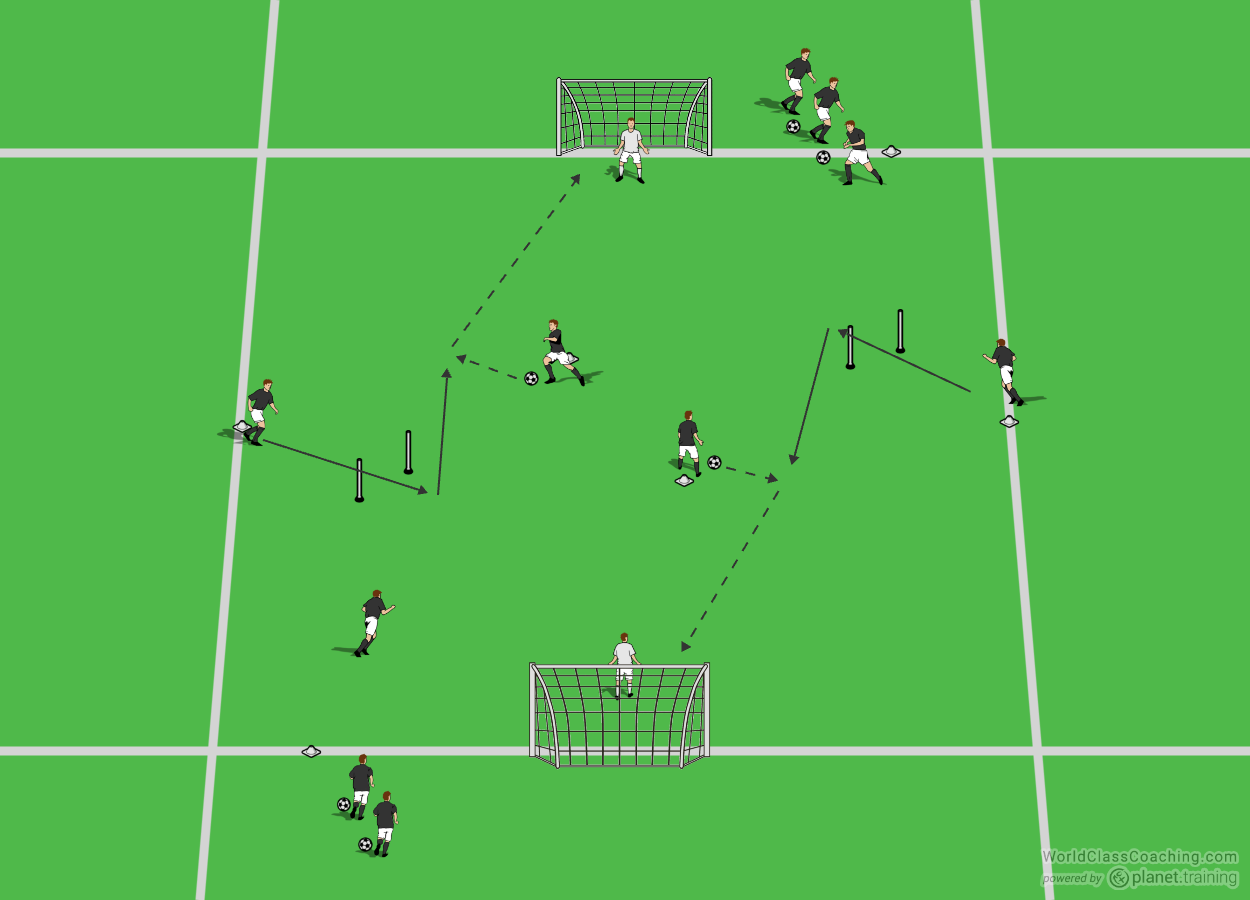
Timing
Each player should make 8-10 repetitions as a ‘shooting’ player. This should be done in 2-4 series with 30 second rest (working as a ‘starting’ or ‘setting’ player) between repetitions and 4 minutes between series.
Variations
- Increase/decrease distances between cones
- Passing off one/two touches
- ‘Shooting’ player passes directly to ‘setting’ player
By Alex Trukan, Development Coach, Nottingham Forest
@AlexTrukan
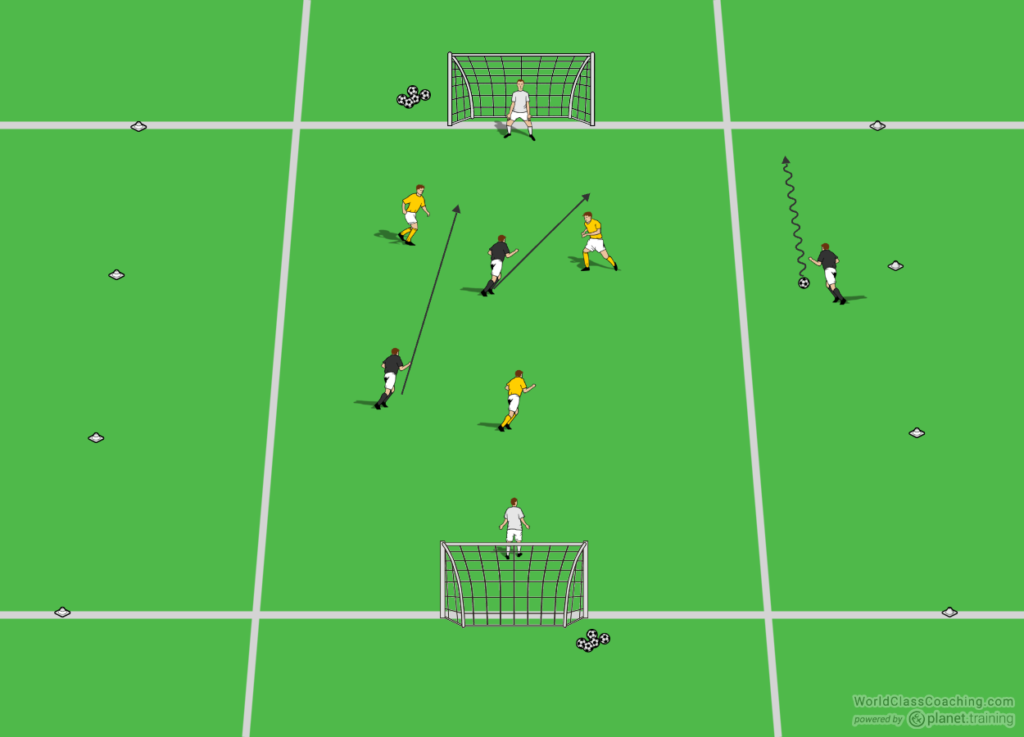
Crossing and Finishing Game
This is one of 28 articles and training sessions on conditioning and other topics that will be published this month in the Training Center. Click Here to learn how you can receive access to all of them.
By Alex Trukan
This practice is designed to improve players’ ability to recover between high intensity actions in a most efficient way. This will allow players to sustain the quality (speed and strength) of their actions for longer throughout the game. These physical outcomes are achieved in a highly technically demanding game containing a lot of crossing and finishing. Small amount of players on each side ensure high intensity and engagement of the players.
Set Up and Directions
Organise a pitch of 25 x 20 yards with three zones – two wide zones (5 yards wide each) and central zone (15 yards wide). Set up two goals on the opposite ends as shown on the diagram below. Divide the group into two teams of three. Set the goalkeepers in goals. Prepare a sufficient supply of balls to ensure flow of the practice.
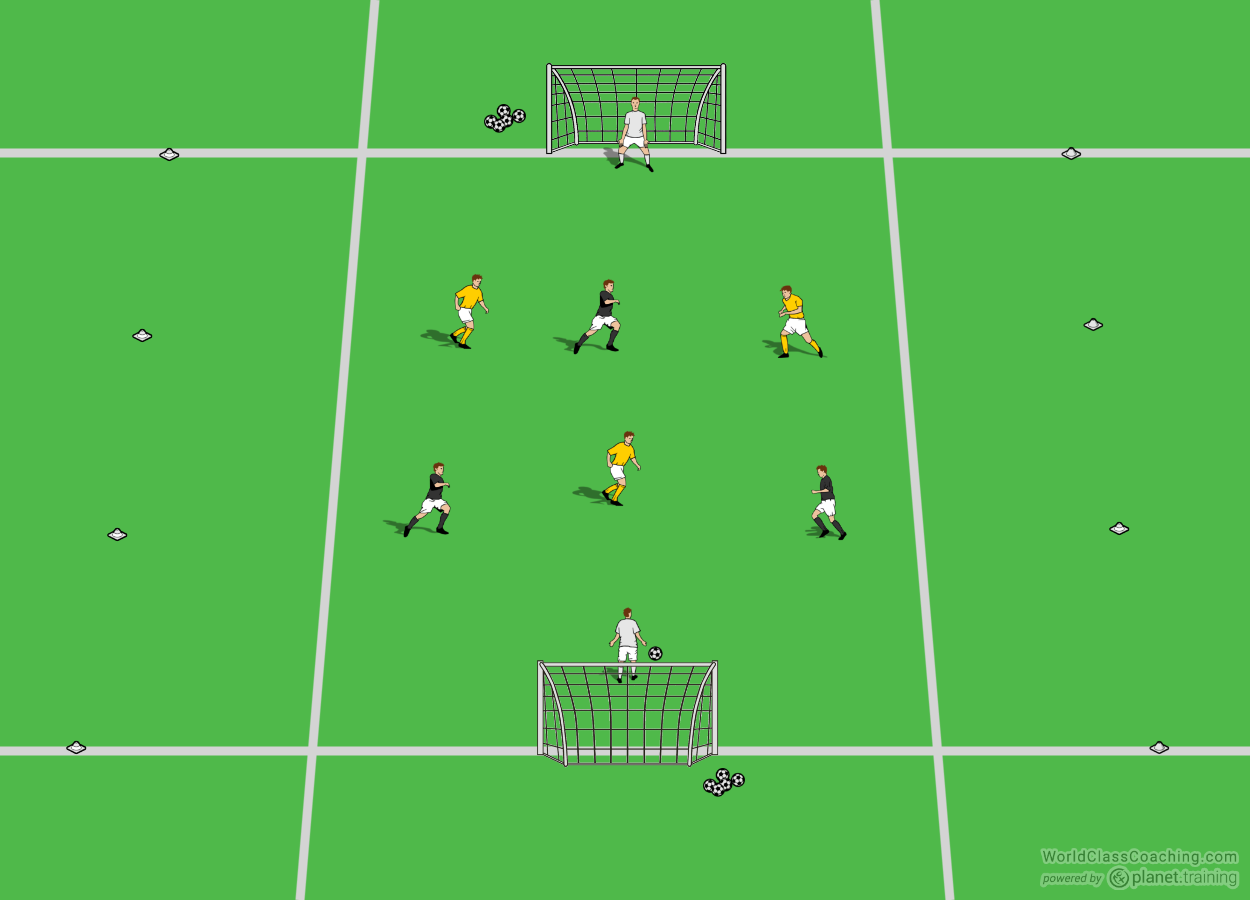
The practice starts with a goalkeeper passing to any of the teams. After this, the aim of the team in possession is to make 3 consecutive passes. This should be completed in the middle part of the pitch.
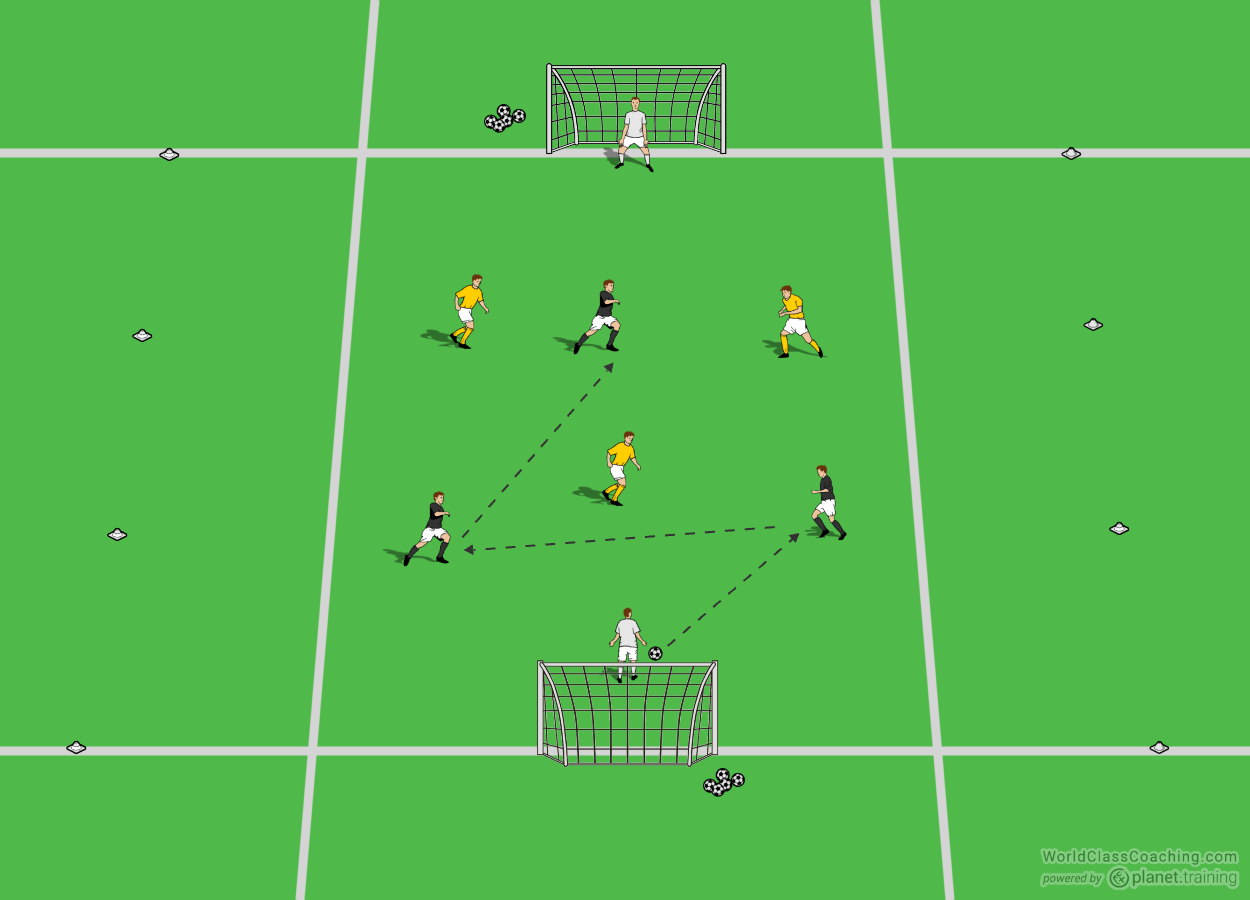
As soon as the 3 passes are made, the ball can be played into one of the wide areas to the player making a movement there (max. two attacking players can be in one wide area). Only one defender can tackle in wide area.
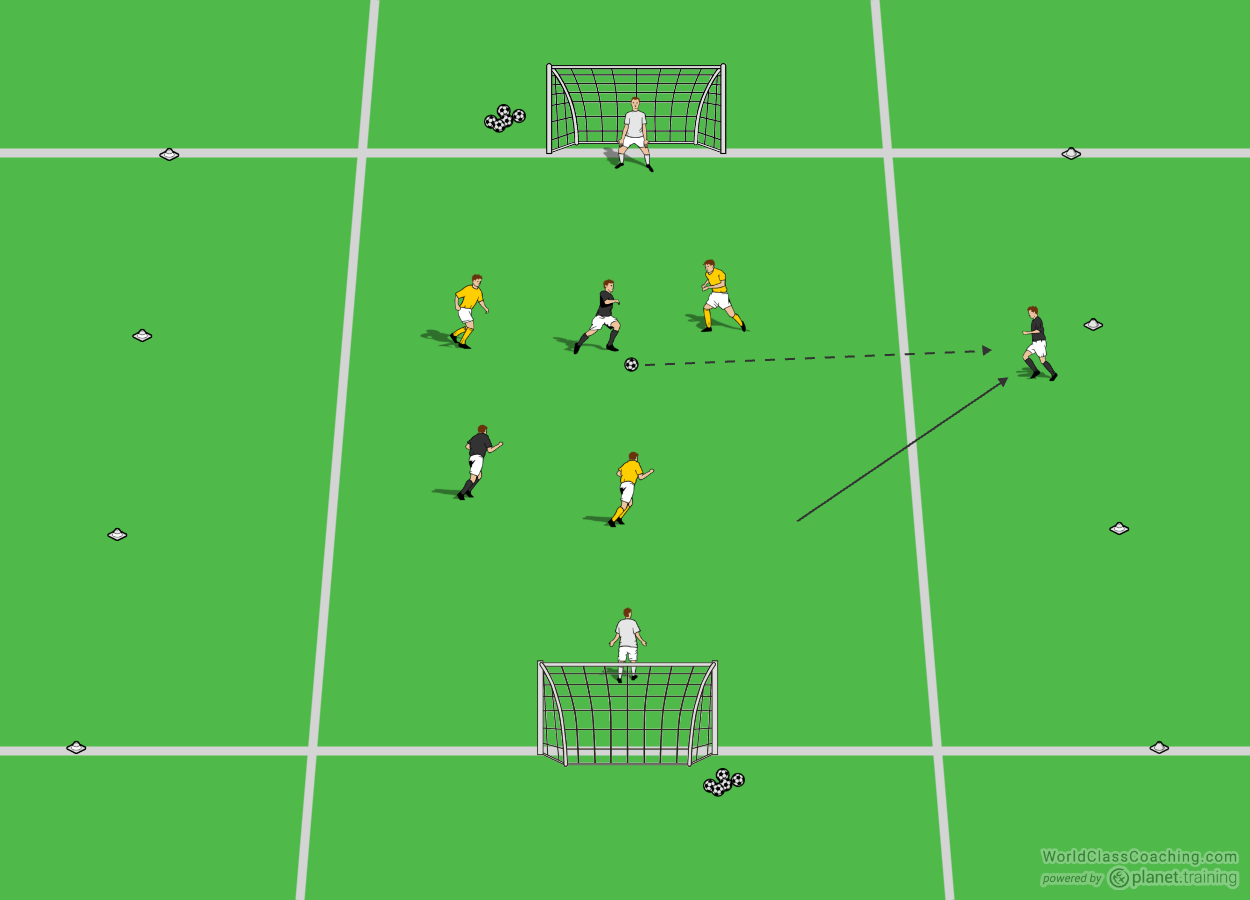
The attacking team can have only three entries into wide areas per attack what will encourage quicker turn overs of possession and more crosses. The ball can be delivered both aerially and on the ground.
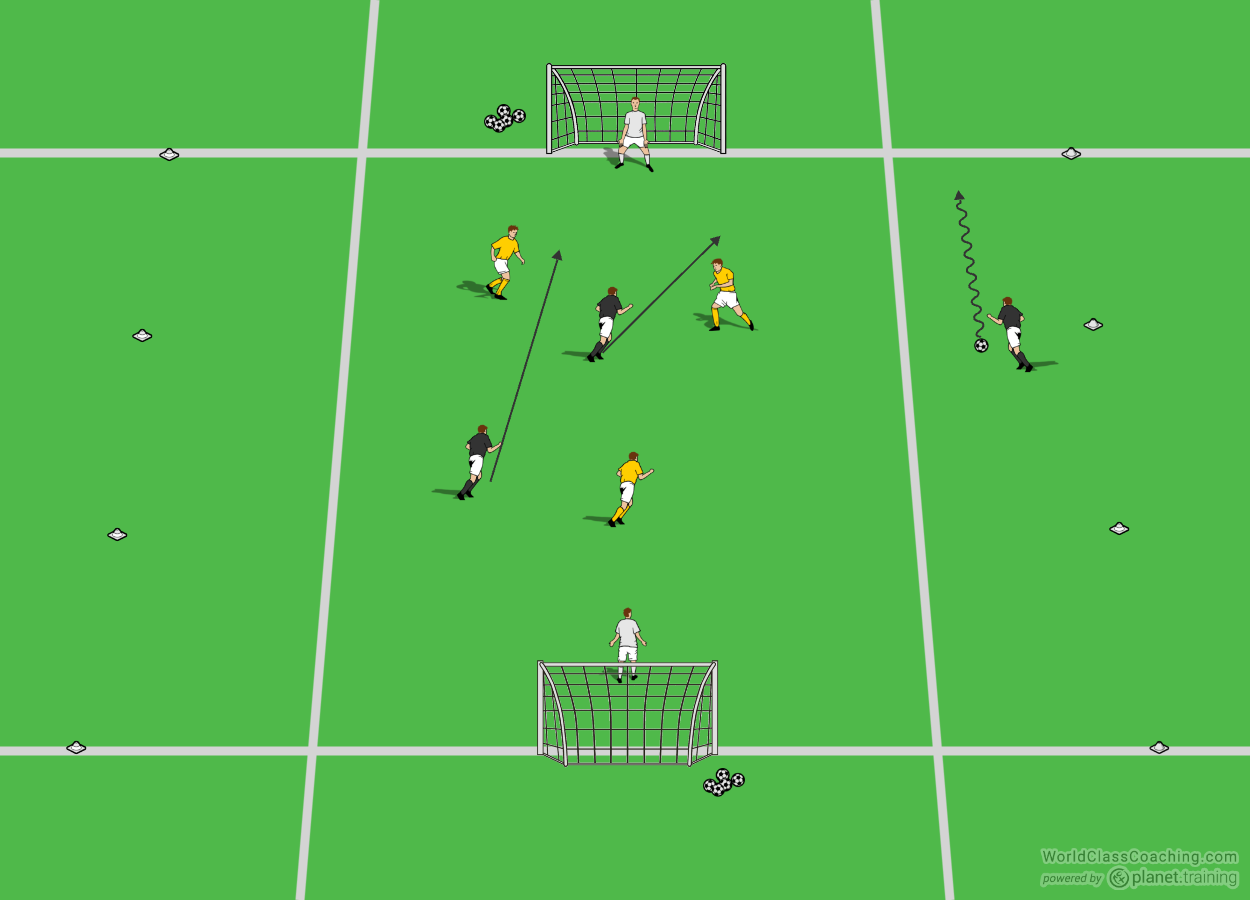
As the wide player is about to deliver the ball, the other players should look to make explosive forward movements to finish. If the ball goes out for a corner, it is restarted from the opposite goalkeeper (no corners).
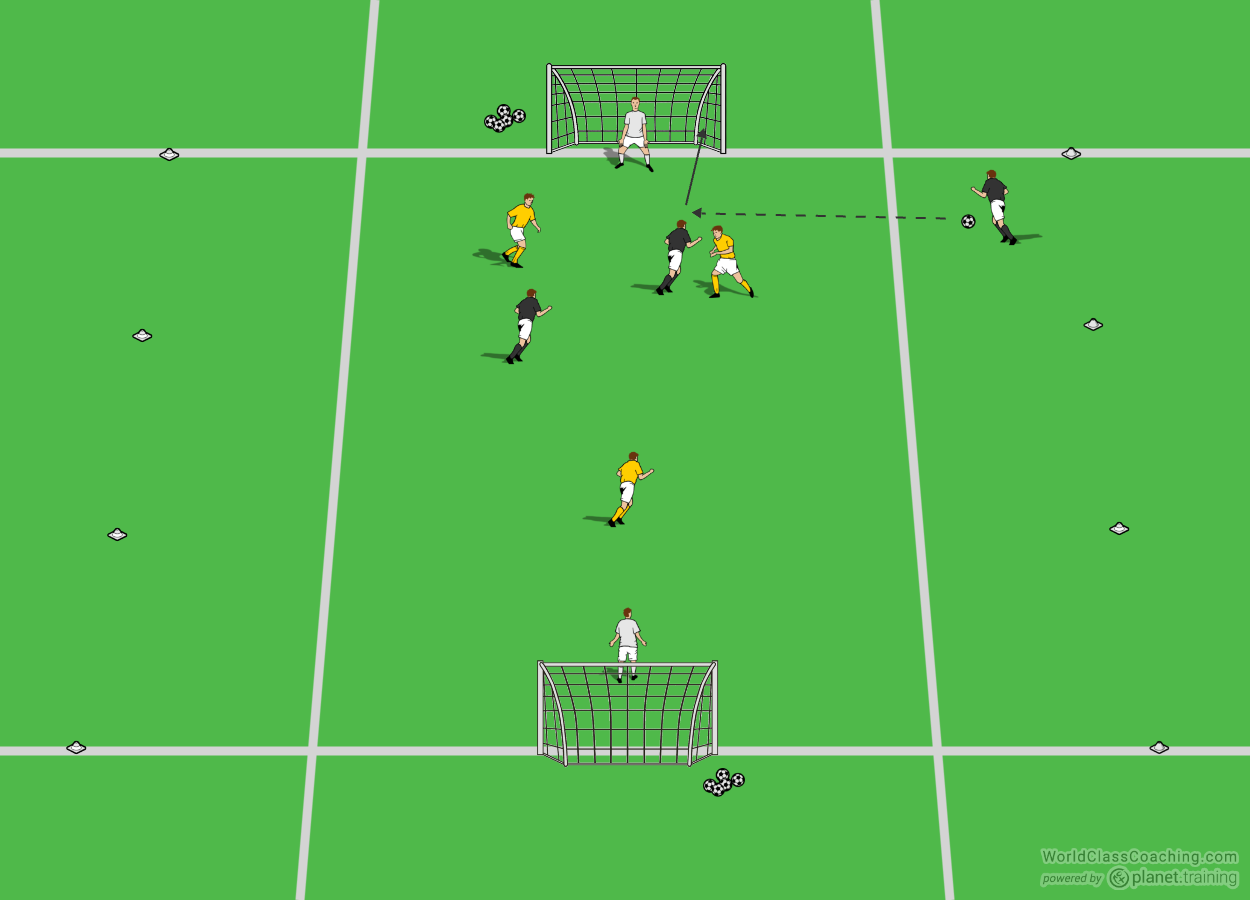
Timing
The practice should last 1-3 minutes and be repeated 6-10 times in 2 series. Rest between repetitions should be 1-3 minutes and between series, 4 minutes.
Variations
- 4v4/3v3+1
- Max. 2 entries into wide areas before a finish
- Min. 2 passes before the ball can be played wide
By Alex Trukan, Development Coach, Nottingham Forest
@AlexTrukan

Rondos with Explosive Power
By Alex Trukan
This practice is designed to improve players’ ability to recover between high intensity actions in a most efficient way. This will allow players to sustain the quality (speed and strength) of their actions for longer throughout the game. These physical outcomes are achieved in a highly technically demanding game containing a lot of crossing and finishing. Small amount of players on each side ensure high intensity and engagement of the players.
Set Up and Directions
Organise a pitch of 25 x 20 yards with three zones – two wide zones (5 yards wide each) and central zone (15 yards wide). Set up two goals on the opposite ends as shown on the diagram below. Divide the group into two teams of three. Set the goalkeepers in goals. Prepare a sufficient supply of balls to ensure flow of the practice.

The practice starts with a goalkeeper passing to any of the teams. After this, the aim of the team in possession is to make 3 consecutive passes. This should be completed in the middle part of the pitch.

As soon as the 3 passes are made, the ball can be played into one of the wide areas to the player making a movement there (max. two attacking players can be in one wide area). Only one defender can tackle in wide area.

The attacking team can have only three entries into wide areas per attack what will encourage quicker turn overs of possession and more crosses. The ball can be delivered both aerially and on the ground.

As the wide player is about to deliver the ball, the other players should look to make explosive forward movements to finish. If the ball goes out for a corner, it is restarted from the opposite goalkeeper (no corners).

Timing
The practice should last 1-3 minutes and be repeated 6-10 times in 2 series. Rest between repetitions should be 1-3 minutes and between series, 4 minutes.
Variations
- 4v4/3v3+1
- Max. 2 entries into wide areas before a finish
- Min. 2 passes before the ball can be played wide
By Alex Trukan, Development Coach, Nottingham Forest
@AlexTrukan
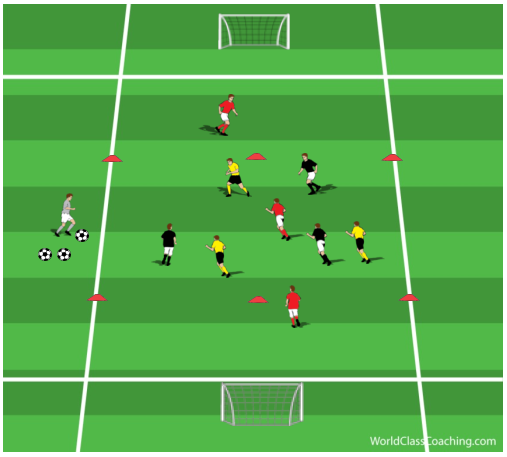
Possession Game with Finishing
By Alex Trukan
This practice has multiple challenges in all facets of the game. Firstly, from the conditioning point of view, it develops explosiveness and power. That is especially required when breaking through defences and around the opposition penalty box. From the technical perspective, it includes elements of passing, combination play as well as finishing. It also challenges players’ decision making on when to speed up play and try to score. Having an end product (shot on goal) makes it engaging and enjoyable for players. The practice is designed for intermediate and advanced players.
Set up and directions
Organise a 20 x 30 yards rectangle. Place two goals on the opposite ends, 15 yards away from the playing area. Divide the players into three teams of three. Two teams are positioned in the middle of the playing area and compete against each other. Third team is neutral, two players from that team are outside the area and one in the middle as shown on the diagram below. The neutral team plays with whichever team is in possession. Prepare a sufficient supply of balls.

The practice starts from the coach playing the ball to one of the attacking teams (not neutral). Which team starts with the ball can be adapted to the group needs and objectives of the session.
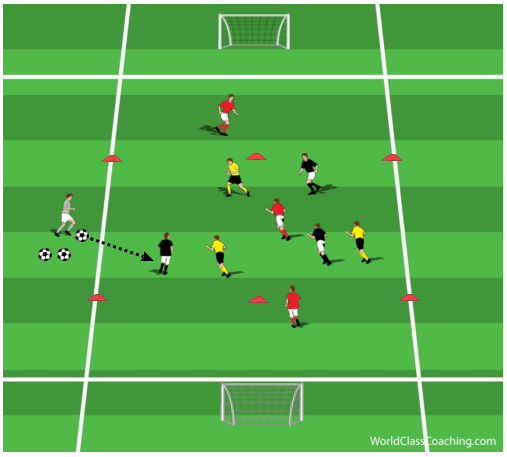
The team is possession then tries to make three passes before breaking through. The second team tries to get in possession with the same objective of making three passes. Neutral players support the team in possession of the ball.
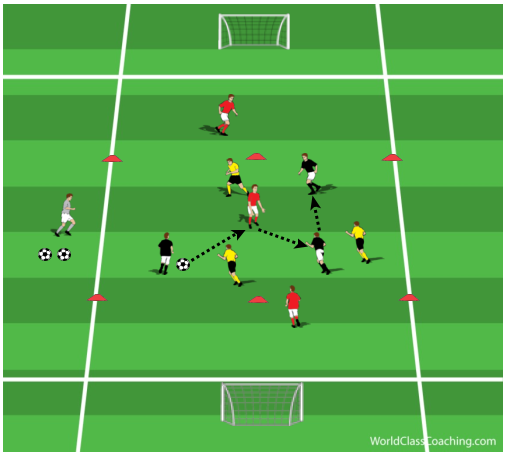
After the team makes three passes, they can play to any of the outside neutral players and break through to finish on goal. Minimum two players have to break through out of the square. The player that played the ball to the neutral player can’t be the one that finishes (forces third man run). The defending team can send out as many players as they want to stop the other team scoring. After the shot is made the practice is restarted from the coach playing the ball to the second team.
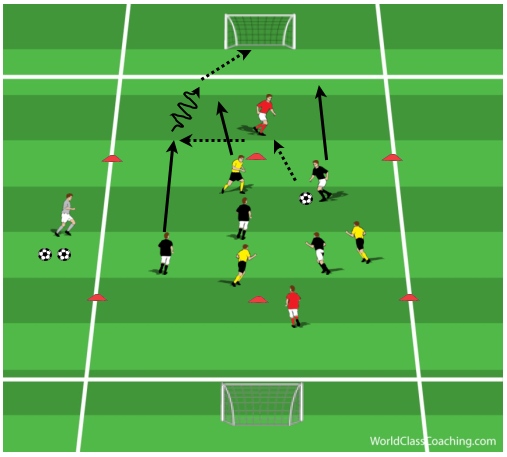
Timing
Both teams compete to ‘break’ 10 times. Every ‘break’ should last no longer than 3 seconds. That should be repeated in 2-4 series with 4 minutes break in between them.
Variations
- 4v4 in the middle
- 2 passes before the ‘break’
- Increase/decrease the distance between the playing area and goals
By Alex Trukan, Development Coach, Nottingham Forest
@AlexTrukan
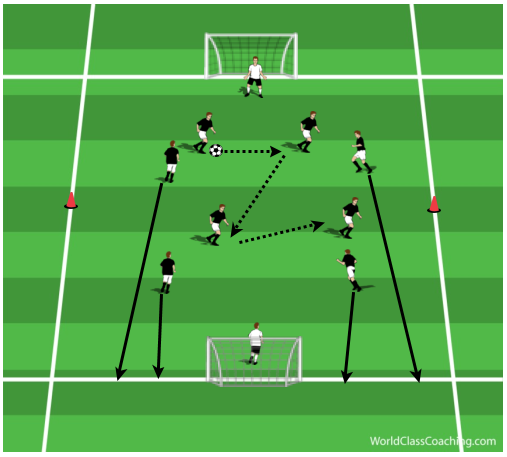
Small Sided Game to Improve Anaerobic Endurance
By Alex Trukan
The presented game is aimed at improving players’ ability to produce more high intensity actions throughout the game. This is achieved in a conditioned game which has elements of defensive transition, combination play as well as recovery runs. The organisation of this practices challenges players to react quickly when losing possession as well as combine play to attack upon winning it. This small sided game has some major tactical trade-offs, however the main area of focus is the physical corner. This practice is well suited for intermediate and advanced players.
Set-Up and Directions
Organise 30 x 40 yards pitch with two goals on the opposite ends. Mark out half way line. Divide the players into two teams of 4. Set goalkeepers in goals. The area size may be bigger if more players are involved. Prepare supply of balls.
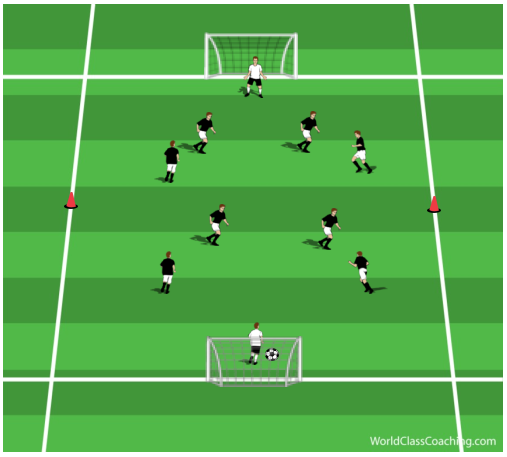
The game starts with a goalkeeper playing out to one of the players from his team. The aim of the team in possession is to score in the opposition goal. Normal rules of football apply.
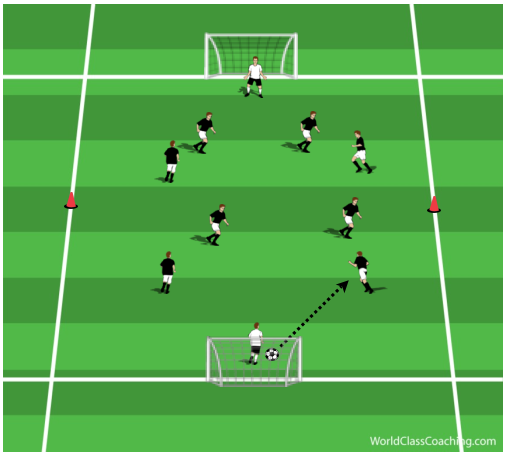
The condition of the game focuses on the moment of losing possession. If the attacking team loses the ball whether it’s after tackle or interception, all of the players from that team have to touch the line by their own goal before they can defend.
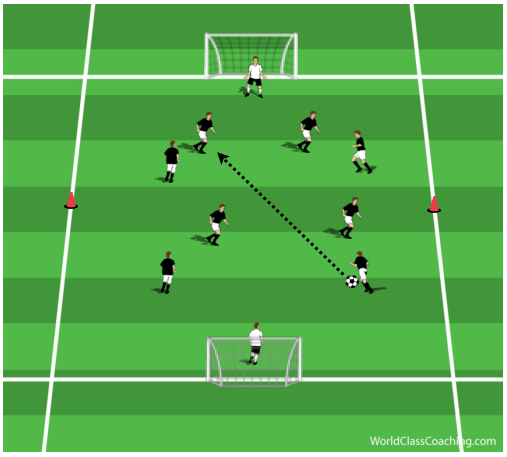
As we can see below, the reaction of the team that lost possession is to make a sprint towards own end line. The team that gained possession in turn, has to make 3 passes before they can attack and shoot.

The challenge for the defending team is to apply pressure on the attackers as soon as possible to prevent shots on target and their progression forwards.
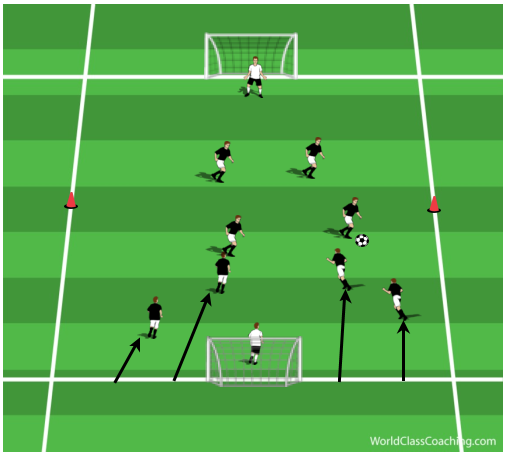
Timing
The game should be played 3 minutes and repeated 6-10 times in 2 series. The rest period between repetitions should be 1- 3 mins and between series – 4 minutes.
Variations
- 4 v 4/6 v 6
- Team that lost possession has to touch specific cone/line set by coach
- Team that won possession has to make 5 passes before making an attack
By Alex Trukan, Development Coach, Nottingham Forest
@AlexTrukan
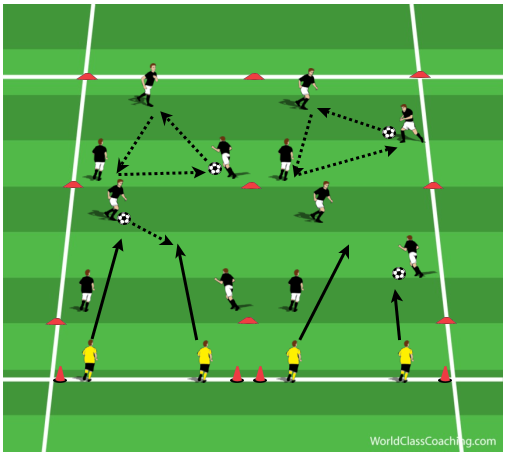
3 v 2 Competition
By Alex Trukan
This practice is designed to improve Anaerobic energy system which is responsible for short-duration, high intensity actions during a match. Therefore, players will develop their ability to produce high quality explosive bursts, which may be useful when applying pressure on the ball or doubling up to win the possession back. From the technical point of view, players involved in this practice also benefit from passing, movement off the ball and staying on the ball skills improvement.
Set Up and Directions
Organise four 6 x 6 yards squares positioned next to each other. That should form two ‘channels’ at the beginning of each, two additional cones should be placed as shown on the diagram below. Those two cones will be starting positions of the defenders. Divide the team into four groups of three and two pairs of defenders. Each group of three players should occupy one of the squares and have one ball between them. Two pairs of defenders should be positioned at the starting cones.
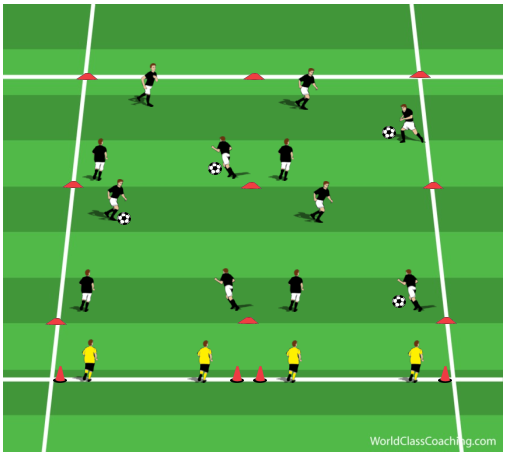
The practice starts with four groups starting to pass the ball in threes, changing positions and moving off the ball within their squares. The defenders are ready and waiting for the coach’s signal.
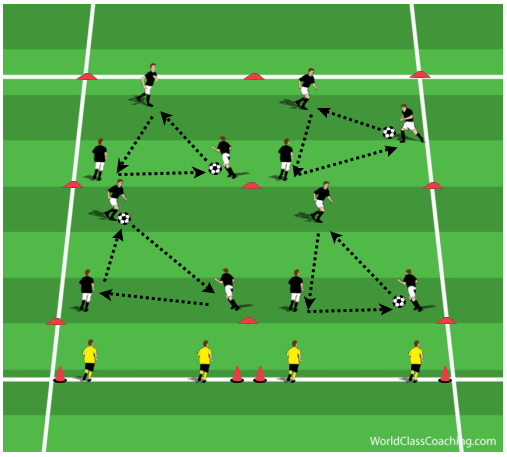

As soon as the defending pair manages to get the ball out of the first square, they should immediately sprint to the next one and try to do the same. Defenders can’t go into the second square before they get the ball out of the first one.
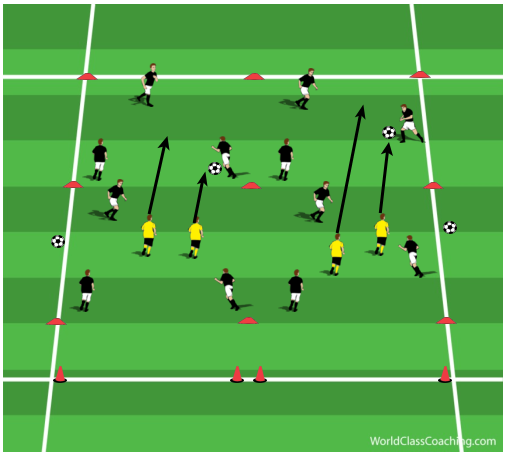
After getting the ball out of the both squares, defenders have to sprint back to their starting positions and flip the cone upside down. Whichever pair finishes doing that first, is considered a winner.
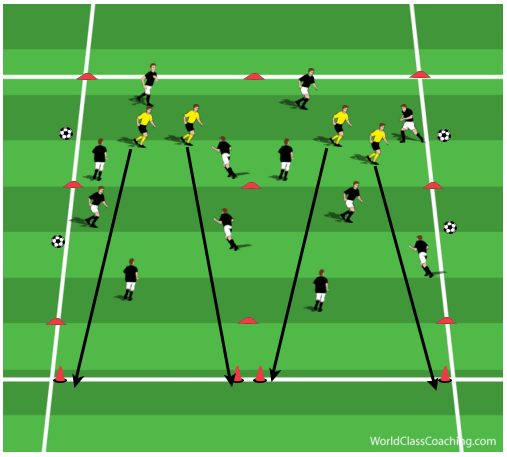
Timing
Each pair should make 4-6 repetitions in 1-2 series. The rest period between repetitions should be 1 minute and between series – 4 minutes (other players working).
Variations
- 4 players in each square
- Defenders have to dribble the ball out of the square/make a pass
- Two squares combined, four defenders working together – 6v4
By Alex Trukan, Development Coach, Nottingham Forest
@AlexTrukan
